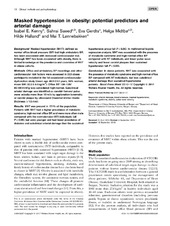| dc.contributor.author | Kenny, Isabel E. | en_US |
| dc.contributor.author | Saeed, Sahrai | en_US |
| dc.contributor.author | Gerdts, Eva | en_US |
| dc.contributor.author | Midtbø, Helga Bergljot | en_US |
| dc.contributor.author | Halland, Hilde | en_US |
| dc.contributor.author | Lønnebakken, Mai Tone | en_US |
| dc.date.accessioned | 2017-09-15T12:13:42Z | |
| dc.date.available | 2017-09-15T12:13:42Z | |
| dc.date.issued | 2017-02 | |
| dc.Published | Kenny, Saeed S, Gerdts E, Midtbø HB, Halland H, Lønnebakken MT. Masked hypertension in obesity: Potential predictors and arterial damage. Blood Pressure Monitoring. 2017;22(1):12-17 | eng |
| dc.identifier.issn | 1473-5725 | |
| dc.identifier.issn | 1359-5237 | |
| dc.identifier.uri | https://hdl.handle.net/1956/16637 | |
| dc.description.abstract | Background: Masked hypertension (MHT), defined as normal office blood pressure (BP) but high ambulatory BP, has been associated with increased cardiovascular risk. Although MHT has been associated with obesity, there is limited knowledge on the prevalence and covariates of MHT in obese cohorts. Methods: Office and ambulatory BP recordings and other cardiovascular risk factors were assessed in 323 obese participants included in the fat-associated cardiovascular dysfunction study (mean age 48.9±9.0 years, 55% women, mean BMI 32.3±4.4 kg/m2). Office BP 130–139/85–89 mmHg was considered high-normal. Subclinical arterial damage was identified as carotid–femoral pulse wave velocity more than 10 m/s by applanation tonometry or carotid plaque by ultrasound (maximal intima–media thickness ≥1.5 mm). Results: MHT was present in 17.1% of the population. Patients with MHT had a higher prevalence of metabolic syndrome, high-normal office BP, and were more often male compared with the normotensive (NT) individuals (all P<0.05), but were younger and had lower prevalence of diabetes and subclinical arterial damage than the sustained hypertensive group (all P<0.05). In multinomial logistic regression analysis, MHT was associated with the presence of metabolic syndrome and high-normal office BP compared with NT individuals, and lower pulse wave velocity and fewer carotid plaques than sustained hypertension (all P<0.05). Conclusion: In obese patients, MHT was associated with the presence of metabolic syndrome and high-normal office BP compared with NT individuals, but less subclinical arterial damage than sustained hypertensive patients. | en_US |
| dc.language.iso | eng | eng |
| dc.publisher | Wolters Kluwer | eng |
| dc.rights | Attribution CC BY-NC-ND | eng |
| dc.rights.uri | http://creativecommons.org/licenses/by-nc-nd/4.0/ | eng |
| dc.subject | arterial damage | eng |
| dc.subject | blood pressure | eng |
| dc.subject | masked hypertension | eng |
| dc.subject | metabolic syndrome | eng |
| dc.subject | Obesity | eng |
| dc.subject | pulse wave velocity | eng |
| dc.title | Masked hypertension in obesity: Potential predictors and arterial damage | en_US |
| dc.type | Peer reviewed | |
| dc.type | Journal article | |
| dc.date.updated | 2017-09-12T09:15:26Z | |
| dc.description.version | publishedVersion | en_US |
| dc.rights.holder | Copyright 2017 Wolters Kluwer Health, Inc | |
| dc.identifier.doi | https://doi.org/10.1097/mbp.0000000000000220 | |
| dc.identifier.cristin | 1470065 | |
| dc.source.journal | Blood Pressure Monitoring | |

